
‘It has been found that skin protects Itself from UV rays by two mechanisms
The first recruits the immune system, inflammation, and DNA repair to heal any burning or damage caused by UV radiation. The second mechanism, pigmentation or tanning, creates a physical buffer to safeguard the skin against future exposure.’
Tweet it Now
"Our discovery was prompted by the surprising finding that low-frequency UV exposure results in higher skin pigmentation," says Prof. Carmit Levy of the Department of Human Genetics and Biochemistry at TAU's Sackler Faculty of Medicine, who led the research for the study with TAU doctoral student Hagar Malcov-Brog. "This provides an in-depth mechanistic understanding of how the skin's response to ultraviolet rays is regulated. Our results support the premise that the evolution of furless human skin led to a UV-protection 'timer.' This timer provided maximum skin protection with minimum damage."The research was the product of a collaboration with Prof. Shai Shen-Orr of the Technion-Israel Institute of Technology and Prof. Mehdi Khaled of Université Paris-Saclay. Technion doctoral student Ayelet Alpert also researched the study, published as the cover story in Molecular Cell on October 25.
Skip a day in the sun
"We have identified a mechanism that spreads like a wave through the skin over 48 hours after initial exposure to ultraviolet rays. This process synchronizes the natural defense mechanisms in the skin," says Prof. Levy. "We concluded that exposure to the sun at a frequency of once every two days leads to optimal protection from sun damage."
Two principal defense mechanisms naturally protect the skin from UV damage. The first recruits the immune system, inflammation, and DNA repair to heal any burning or damage caused by UV radiation that can ultimately cause skin cancer. The second mechanism, pigmentation or tanning, creates a physical buffer to safeguard the skin against future exposure.
Advertisement
To deepen their understanding of the process, the Technion researchers then built a mathematical model of the finding, which shows that MITF, the protein controlling the two skin protection mechanisms, spreads in the skin in a wave-like form, synchronizing the two protective mechanisms. "The frequency of the wave is 48 hours," says Prof. Shen-Orr. "Imagine you tossed a stone into a pond and saw the ripples spread. Then, before they settled down, you threw in another stone, interrupting the process."
Advertisement
The researchers are currently exploring the reason, perhaps related to Vitamin D levels, behind the biological mechanism.
Source-Eurekalert















